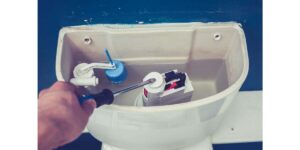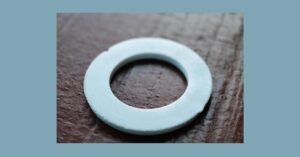Are you wondering if toilet flappers are universal? Well, the short answer is no, they’re not.
But fear not; this article will guide you through the differences and help you find the perfect flapper for your toilet.
Keep reading to avoid any flushing mishaps and save money on water bills.
- What is Toilet Flappers?
- Types of Toilet Flappers
- Size of Toilet Flapper
- Methods to Determine Toilet Flapper Size
- Understanding Toilet Flapper Compatibility
- Popular Toilet Flapper Brands and Compatibility
- Pros and Cons of Universal Toilet Flappers
- How to Choose the Right Toilet Flapper
- Tips for Toilet Flapper Replacement
- Conclusion
What is Toilet Flappers?
Toilet flappers are valves controlling water flow from the tank to the bowl.
They come in various shapes, sizes, and materials, including rubber and silicone.
The flapper is attached to a chain that lifts it when the toilet is flushed, allowing water to enter the bowl.
Understanding the different types of flappers is essential to choosing the right one for your toilet.
Types of Toilet Flappers
There are three main types of toilet flappers: seat disks, tank balls, and rubber.
To identify which type of toilet flapper you have, you can remove the top of the toilet tank and examine it.
Seat Disk
Seat disk toilet flappers are the oldest type of toilet flapper, with a small circular disk that covers the overflow pipe, preventing water from flowing through it.
A reservoir of water is used as a weight to keep the flapper open when flushing. However, when flushed, the reservoir drains out, causing the flapper to close after a certain time.
Unfortunately, seat disk flappers are usually large, taking up a disproportionate amount of space in the toilet tank.
This makes them difficult to replace and find replacements.
Tank Ball
In this type of toilet, the tank ball flapper sits on top of the overflow pipe, and when flushed, the rubber ball is lifted by a chain straight up and off the overflow pipe. This allows water to pass through.
If you have a tank ball flapper, you must ensure the chain holding the ball is the correct length.
Otherwise, it may fail to lift or prevent the ball from returning to its place, resulting in water wastage and a failure to seal the toilet properly.
Rubber
Rubber flappers are the most common type of toilet flapper in recent toilets.
A simple cap attaches to the overflow pipe, and when the toilet is flushed, a mechanism pulls a chain attached to the flapper to lift it.
When the flushing is complete, the chain allows the cap to drop back into place. Although “rubber” may seem misleading, not all flappers of this kind are made entirely of rubber.
Sometimes, they only use an outer edge made of rubber to seal tightly against the overflow pipe.
While rubber flappers are the most common and reliable, they share a disadvantage with tank ball flappers.
An incorrectly sized chain can cause water leakage.
Size of Toilet Flapper
In addition to the type of toilet flapper, it is vital to ensure you purchase the correct size for your toilet.
While universal-sized toilet flappers used to be the norm, they now range from 2″ to 4″ in size.
Two factors typically determine the size of the flapper that your toilet uses.
- Date of manufacture: More recently manufactured toilets use 3″ or 4″ flappers instead of 2″.
- Gallons per flush (GPF) amount: The Gallons per flush (GPF) measure refers to the volume of water that enters and exits the toilet tank during flushing. It is crucial to determine the GPF of your toilet and whether it is classified as full flow or low flow. Typically, toilets with 1.6 and 1.28 GPF have 3″ toilet flapper valves.
Methods to Determine Toilet Flapper Size
There are various techniques to determine the size of your toilet flapper if you are unsure about it.
Method 1: Check the Make and Model – If you are aware of the make and model of your toilet, you can look it up to find out the size of your toilet flapper.
If you are unaware of the make and model, examine the interior of the tank for the model number.
The model number may be on the tank’s inner walls or cover.
Search for this number and the manufacturer’s name to discover the appropriate flapper size.
Method 2: Examine the Opening – If the opening appears larger, approximately the size of a grapefruit or softball, you will require a 3″ or 4″ flapper.
Understanding Toilet Flapper Compatibility
The term “universal” in plumbing refers to parts compatible with most fixtures.
However, when it comes to toilet flappers, not all designs are universal.
The compatibility of flappers depends on several factors, including the age and design of the toilet, water efficiency, material and design of the flapper, and valve seat deterioration.
Some toilet types require specific flapper designs for efficient flushings, such as dual flush toilets or those with adjustable flappers.
Checking the manufacturer’s specifications and recommendations for proper fit is essential to avoid leakage, water waste, or reduced flushing power issues.
Popular Toilet Flapper Brands and Compatibility
Several well-known brands of toilet flappers include Korky, Fluidmaster, and American Standard.
Korky is notable for producing replacement parts for both newer and older toilets.
Fluidmaster offers adjustable flappers that fit popular 3-inch toilet models such as Kohler, TOTO, American Standard, Gerber, and Mansfield.
American Standard provides a complete dual flapper assembly for Vormax series toilets and a float flapper for 2-inch valves without additional adjustments.
It is essential to check the manufacturer’s warranty and specifications to ensure the flapper is suitable for your toilet.
Pros and Cons of Universal Toilet Flappers
Using universal toilet flappers has several advantages, including easy installation and replacement, lower costs, and availability in most hardware stores.
There are also disadvantages to using universal flappers, such as reduced flushing power, less durability, and potential water efficiency and leakage issues.
Careful selection and proper installation can mitigate these disadvantages.
How to Choose the Right Toilet Flapper
Choosing the right toilet flapper involves considering several factors, such as the flapper’s size, shape, and material, as well as the age and water efficiency of the toilet.
Following the manufacturer’s recommendations for chain length and installation is also essential.
If you are still deciding which flapper to choose, seek advice from a professional plumber.
Tips for Toilet Flapper Replacement
Replacing a toilet flapper can be a DIY repair, but it is essential to follow the proper steps.
Signs that a toilet flapper needs replacement include water leaks and inconsistent flushing.
Before installation, turn off the water supply and clean the valve seat.
Follow the manufacturer’s instructions for installation and adjustment.
Replacing Your Toilet Flapper
Once you have identified the type and size of your toilet flapper, it is time to replace it. The process is relatively straightforward and can be completed with simple tools.
- Turn off the water supply to the toilet. The valve is typically located on the wall behind the toilet.
- Remove the lid of the toilet tank and flush the toilet. This will drain the water out of the tank.
- Remove the existing flapper by detaching it from the chain or sliding it off its mounting pegs.
- Install the new flapper in the reverse removal order, ensuring it is properly seated and secured.
- Turn the water supply back on and test the toilet to ensure it functions correctly.
Conclusion
Toilet flappers play a crucial role in maintaining water efficiency and preventing leakage.
Choosing and replacing the right flapper involves considering several factors, such as the flapper’s size, shape, and material, as well as the age and water efficiency of the toilet.
Checking the manufacturer’s specifications and recommendations is also essential.
Replacing faulty toilet flappers can prevent water waste and damage to your home, making it a worthwhile investment.




